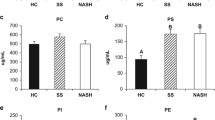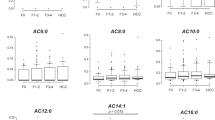Abstract
A large proportion of the Chinese population is now at risk of non-alcoholic fatty liver disease (NAFLD). We aimed to investigate the relationship between plasma phospholipids (PL) fatty acids and the risk of NAFLD. One hundred NAFLD patients and 100 healthy subjects were recruited in Hangzhou, China. Plasma PL and selected biochemical and hematological parameters were analyzed by using standard methods. Stepwise logistic regression was used to identify independent risk factors of NAFLD. Plasma PL total saturated fatty acid (SFA), C20:3n-6, serum alanine aminotransferase, high-density lipoprotein cholesterol, and body mass index were independent risk factors of NAFLD. The risk of NAFLD was significantly increased with higher quartiles of plasma PL total SFA (P for trend = 0.028) and C20:3n-6 (P for trend <0.001); plasma PL docosahexaenoic acid (C22:6n-3) was significantly lower in NAFLD patients than in controls (P = 0.032) and the OR of NAFLD in the highest quartile of C22:6n-3 was 0.41 (95 % CI = 0.17–0.97) compared with the lowest quartile. In conclusion, plasma PL total SFA and C20:3n-6 are positively correlated with the risk of NAFLD, while C22:6n-3 is negatively correlated with the risk of NAFLD.





Similar content being viewed by others
Abbreviations
- ALP:
-
Alkaline phosphatase
- ALT:
-
Alanine aminotransferase
- BMI:
-
Body mass index
- BUN:
-
Blood urea nitrogen
- DBP:
-
Diastolic blood pressure
- DBil:
-
Direct bilirubin
- GGT:
-
Gamma-glutamyl transferase
- HDL-C:
-
High-density lipoprotein cholesterol
- IBil:
-
Indirect bilirubin
- LDL-C:
-
Low-density lipoprotein cholesterol
- MS:
-
Metabolic syndrome
- NAFLD:
-
Non-alcoholic fatty liver disease
- OR:
-
Odds ratio
- PL:
-
Phospholipids
- PUFA:
-
Polyunsaturated fatty acid(s)
- SBP:
-
Systolic blood pressure
- SFA:
-
Saturated fatty acid(s)
- TBil:
-
Total bilirubin
- TC:
-
Total cholesterol
- TG:
-
Triacylglycerol(s)
References
Angulo P (2007) GI epidemiology: nonalcoholic fatty liver disease. Aliment Pharmacol Ther 25:883–889
Fan JG, Farrell GC (2009) Epidemiology of non-alcoholic fatty liver disease in China. J Hepatol 50:204–210
Farrell GC, Chitturi S, Lau GK, Sollano JD (2007) Guidelines for the assessment and management of non-alcoholic fatty liver disease in the Asia-Pacific region: executive summary. J Gastroenterol Hepatol 22:775–777
Riquelme A, Arrese M, Soza A, Morales A, Baudrand R, Perez-Ayuso RM, Gonzalez R, Alvarez M, Hernandez V, Garcia-Zattera MJ, Otarola F, Medina B, Rigotti A, Miquel JF, Marshall G, Nervi F (2009) Non-alcoholic fatty liver disease and its association with obesity, insulin resistance and increased serum levels of C-reactive protein in Hispanics. Liver Int 29:82–88
Goessling W, Massaro JM, Vasan RS, D’Agostino RB Sr, Ellison RC, Fox CS (2008) Aminotransferase levels and 20-year risk of metabolic syndrome, diabetes, and cardiovascular disease. Gastroenterology 135:1935–1944
Targher G (2007) Non-alcoholic fatty liver disease, the metabolic syndrome and the risk of cardiovascular disease: the plot thickens. Diabet Med 24:1–6
Fan JG, Zhu JN, Li XJ, Chen L, Lu YS, Li L, Dai F, Li F, Chen SY (2005) Fatty liver and the metabolic syndrome among Shanghai adults. J Gastroenterol Hepatol 20:1825–1832
Sathiaraj E, Chutke M, Reddy MY, Pratap N, Rao PN, Reddy DN, Raghunath M (2011) A case-control study on nutritional risk factors in non-alcoholic fatty liver disease in Indian population. Eur J Clin Nutr 65:533–537
Fan JG, Saibara T, Chitturi S, Kim BI, Sung JJ, Chutaputti A (2007) What are the risk factors and settings for non-alcoholic fatty liver disease in Asia-Pacific? J Gastroenterol Hepatol 22:794–800
Amarapurkar DN, Hashimoto E, Lesmana LA, Sollano JD, Chen PJ, Goh KL (2007) How common is non-alcoholic fatty liver disease in the Asia-Pacific region and are there local differences? J Gastroenterol Hepatol 22:788–793
Sessler AM, Ntambi JM (1998) Polyunsaturated fatty acid regulation of gene expression. J Nutr 128:923–926
Musso G, Gambino R, De Michieli F, Cassader M, Rizzetto M, Durazzo M, Faga E, Silli B, Pagano G (2003) Dietary habits and their relations to insulin resistance and postprandial lipemia in nonalcoholic steatohepatitis. Hepatology 37:909–916
Zelber-Sagil S, Nitzan-Kaluski D, Goldsmith R, Webb M, Blendis L, Halpern Z, Oren R (2007) Long term nutritional intake and the risk for non-alcoholic fatty liver disease (NAFLD): A population based study. J Hepatol 47:711–717
Oya J, Nakagami T, Sasaki S, Jimba S, Murakami K, Kasahara T, Wasada T, Sekiguchi H, Hasegawa M, Endo Y, Iwamoto Y (2010) Intake of n-3 polyunsaturated fatty acids and non-alcoholic fatty liver disease: a cross-sectional study in Japanese men and women. Eur J Clin Nutr 64:1179–1185
Spadaro L, Magliocco O, Spampinato D, Piro S, Oliveri C, Alagona C, Papa G, Rabuazzo AM, Purrello F (2008) Effects of n-3 polyunsaturated fatty acids in subjects with nonalcoholic fatty liver disease. Dig Liver Dis 40:194–199
Sofi F, Giangrandi I, Cesari F, Corsani I, Abbate R, Gensini GF, Casini A (2010) Effects of a 1-year dietary intervention with n-3 polyunsaturated fatty acid-enriched olive oil on non-alcoholic fatty liver disease patients: a preliminary study. Int J Food Sci Nutr 61:792–802
Huang T, Wahlqvist ML, Xu TC, Xu A, Zhang AZ, Li D (2010) Increased plasma n-3 polyunsaturated fatty acid is associated with improved insulin sensitivity in type 2 diabetes in China. Mol Nutr Food Res 54:S112–S119
Huang T, Bhulaidok S, Cai ZZ, Xu TC, Xu F, Wahlqvist ML, Li D (2010) Plasma phospholipids n-3 polyunsaturated fatty acid is associated with metabolic syndrome. Mol Nutr Food Res 54:1628–1635
Neuschwander-Tetri BA, Caldwell SH (2003) Nonalcoholic steatohepatitis: summary of an AASLD Single Topic Conference. Hepatology 37:1202–1219
Sinclair AJ, O’Dea K, Dunstan G, Ireland PD, Niall M (1987) Effects on plasma lipids and fatty acid composition of very low fat diets enriched with fish or kangaroo meat. Lipids 22:523–529
Riboli E, Ronnholm H, Saracci R (1987) Biological Markers of Diet. Cancer Surv 6:685–718
Hunter D (1995) Biochemical indicators of dietary intake. In: Willett WC (ed) Nutritional epidemiology, Oxford University Press, New York, p 143–203
Larter CZ, Yeh MM, Van Rooyen DM, Teoh NC, Brooling J, Hou JY, Williams J, Clyne M, Nolan CJ, Farrell GC (2009) Roles of adipose restriction and metabolic factors in progression of steatosis to steatohepatitis in obese, diabetic mice. J Gastroenterol Hepatol 24:1658–1668
Woollett LA, Spady DK, Dietschy JM (1992) Regulatory effects of the saturated fatty-acids 6-0 through 18-0 on hepatic low-density-lipoprotein receptor activity in the Hamster. J Clin Invest 89:1133–1141
Spady DK, Woollett LA, Dietschy JM (1993) Regulation of plasma LDL-cholesterol levels by dietary cholesterol and fatty acids. Annu Rev Nutr 13:355–381
Vallim T, Salter AM (2010) Regulation of hepatic gene expression by saturated fatty acids. Prostaglandins Leukot Essent Fatty Acids 82:211–218
Yoshikawa T, Shimano H, Yahagi N, Ide T, Amemiya-Kudo M, Matsuzaka T, Nakakuki M, Tomita S, Okazaki H, Tamura Y, Iizuka Y, Ohashi K, Takahashi A, Sone H, Osuga Ji J, Gotoda T, Ishibashi S, Yamada N (2002) Polyunsaturated fatty acids suppress sterol regulatory element-binding protein 1c promoter activity by inhibition of liver X receptor (LXR) binding to LXR response elements. J Biol Chem 277:1705–1711
Allard JP, Aghdassi E, Mohammed S, Raman M, Avand G, Arendt BM, Jalali P, Kandasamy T, Prayitno N, Sherman M, Guindi M, Ma DW, Heathcote JE (2008) Nutritional assessment and hepatic fatty acid composition in non-alcoholic fatty liver disease (NAFLD): a cross-sectional study. J Hepatol 48:300–307
Tanaka N, Sano K, Horiuchi A, Tanaka E, Kiyosawa K, Aoyama T (2008) Highly purified eicosapentaenoic acid treatment improves nonalcoholic steatohepatitis. J Clin Gastroenterol 42:413–418
Araya J, Rodrigo R, Videla LA, Thielemann L, Orellana M, Pettinelli P, Poniachik J (2004) Increase in long-chain polyunsaturated fatty acid n-6/n-3 ratio in relation to hepatic steatosis in patients with non-alcoholic fatty liver disease. Clin Sci 106:635–643
Fan JG, Peng YD (2007) Metabolic syndrome and non-alcoholic fatty liver disease: Asian definitions and Asian studies. Hepatobiliary Pancreat Dis Int 6:572–578
Puri P, Wiest MM, Cheung O, Mirshahi F, Sargeant C, Min HK, Contos MJ, Sterling RK, Fuchs M, Zhou H, Watkins SM, Sanyal AJ (2009) The plasma lipidomic signature of nonalcoholic steatohepatitis. Hepatology 50:1827–1838
Fu CC, Chen MC, Li YM, Liu TT, Wang LY (2009) The risk factors for ultrasound-diagnosed non-alcoholic fatty liver disease among adolescents. Ann Acad Med Singap 38:15–21
Cardoso CRL, Leite NC, Salles GF, Araujo ALE, Villela-Nogueira CA (2009) Prevalence and associated factors of non-alcoholic fatty liver disease in patients with type-2 diabetes mellitus. Liver Int 29:113–119
Ruhl CE, Everhart JE (2003) Determinants of the association of overweight with elevated serum alanine aminotransferase activity in the United States. Gastroenterology 124:71–79
Zelber-Sagi S, Nitzan-Kaluski D, Halpern Z, Oren R (2006) Prevalence of primary non-alcoholic fatty liver disease in a population-based study and its association with biochemical and anthropometric measures. Liver Int 26:856–863
Kim BK, Han KH, Ahn SH (2011) “Normal” range of alanine aminotransferase levels for Asian population. J Gastroenterol Hepatol 26:219–220
Ford ES, Giles WH, Dietz WH (2002) Prevalence of the metabolic syndrome among US adults—findings from the third national health and nutrition examination survey. JAMA 287:356–359
Nestel P, Lyu R, Low LP, Sheu WH, Nitiyanant W, Saito I, Tan CE (2007) Metabolic syndrome: recent prevalence in East and Southeast Asian populations. Asia Pac J Clin Nutr 16:362–367
Li Y, Xu C, Yu C, Xu L, Miao M (2009) Association of serum uric acid level with non-alcoholic fatty liver disease: a cross-sectional study. J Hepatol 50:1029–1034
Bajaj S, Nigam P, Luthra A, Pandey RM, Kondal D, Bhatt SP, Wasir JS, Misra A (2009) A case-control study on insulin resistance, metabolic co-variates & prediction score in non-alcoholic fatty liver disease. Indian J Med Res 129:285–292
Uchil D, Pipalia D, Chawla M, Patel R, Maniar S, Narayani, Juneja A (2009) Non-alcoholic fatty liver disease (NAFLD)–the hepatic component of metabolic syndrome. J Assoc Physicians India 57:201–204
Ma J, Folsom AR, Shahar E, Eckfeldt JH (1995) Plasma fatty-acid composition as an indicator of habitual dietary-fat intake in middle-aged adults. Am J Clin Nutr 62:564–571
Acknowledgments
The study was funded by the National Natural Science Foundation of China (NSFC, No. 30972464), the National Basic Research Program of China (973 Program: 2011CB504002), Natural Science Foundation of Zhejiang Province (Y205709) and Zhejiang University (No. H20091920).
Conflict of interest
The authors have declared that there is no potential conflict of interest with respect to this manuscript.
Author information
Authors and Affiliations
Corresponding author
About this article
Cite this article
Zheng, JS., Xu, A., Huang, T. et al. Low Docosahexaenoic Acid Content in Plasma Phospholipids is Associated with Increased Non-alcoholic Fatty Liver Disease in China. Lipids 47, 549–556 (2012). https://doi.org/10.1007/s11745-012-3671-4
Received:
Accepted:
Published:
Issue Date:
DOI: https://doi.org/10.1007/s11745-012-3671-4




